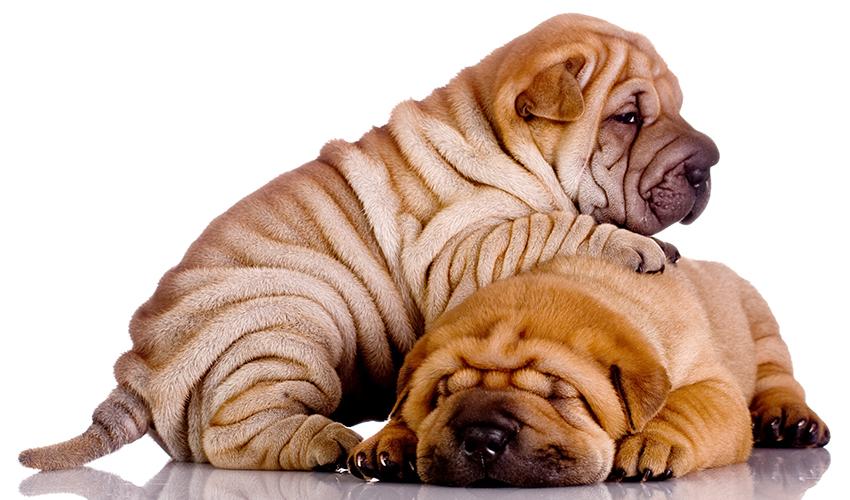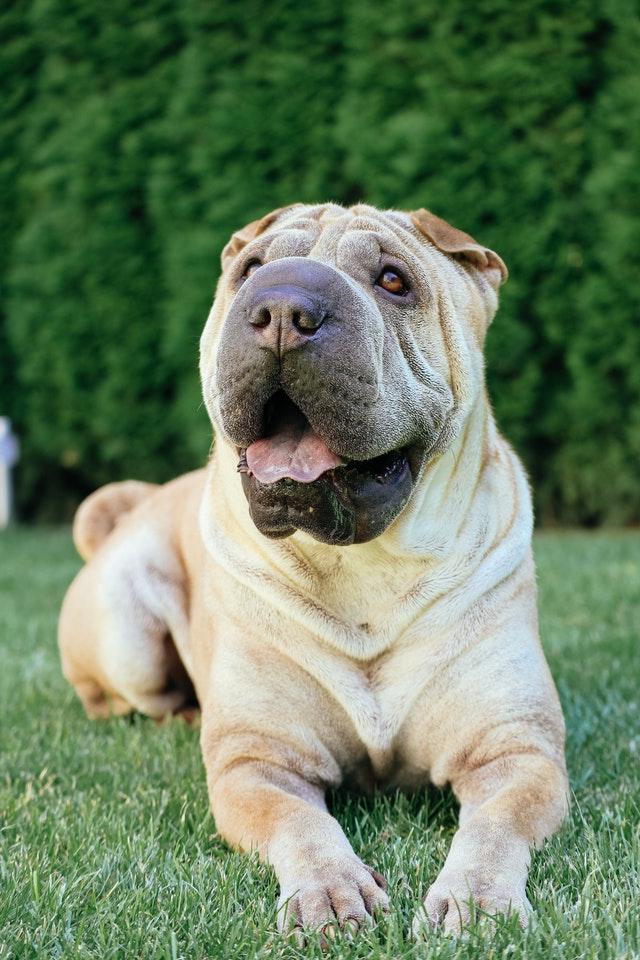- Breed Category: Non-sporting group
- Country of Origin: China
- Average Height: 46-51 cm (18-20 in)
- Average Weight: 18-29 kg (40-64 lbs)
- Average Life Span: 8-12 years
- Grooming Requirements: Low, occasional brushing needed
- Exercise Requirements: Moderate, daily walks
- Coat Type: Short, bristly
- Coat Color Variations: Black, fawn, red, cream
- Shedding Level: Low
- Ear Type: Small, triangular
- Tail Type: Curled over back
- Temperament: Loyal, independent, reserved
- Intelligence Level: Moderate
- Barking Tendency: Low
- Compatibility with Children: Good with supervision
- Compatibility with Other Pets: Varies, early socialisation helps
- Training Ease: Can be challenging, needs patience
- Common Health Issues: Skin issues, hip dysplasia
- Dietary Needs: High-quality, balanced diet
- Energy Level: Moderate
- Drooling Tendency: Low
- Sensitivity to Weather: Sensitive to heat
- Overall Maintenance Level: Moderate
- Original Purpose: Guarding, hunting
- Year of Recognition by Kennel Clubs: 1992
- Apartment Friendly: Yes, with sufficient exercise
- Best Suited For: Families, experienced dog owners
- Cost of Ownership: Moderate to high
- Unique Traits: Wrinkled skin, blue-black tongue
- Cultural Significance: Ancient Chinese breed
- Popularity Rank: Moderately popular
Think all wrinkly dogs are the same? Let’s dive into the world of the Shar Pei, a breed that stands out with its unique appearance and rich history. Originating from China, the Shar Pei is instantly recognisable by its deep wrinkles and blue-black tongue. These dogs were once prized for their guarding abilities and loyalty. Today, they’re cherished companions known for their calm and independent nature. This article will guide you through the fascinating characteristics of the Shar Pei, explore its historical roots, and offer insights into caring for this distinctive breed. Whether you’re considering adding a Shar Pei to your family or simply curious, understanding their needs and traits is key to a happy, healthy relationship.
History and Origin of the Shar Pei

Early Development in China
The Shar Pei’s journey began in the southern provinces of China, where it was bred for its versatility. Originally, these dogs were farm helpers, hunters, and guardians. Their unique features, like the loose skin and bristly coat, were not just for show. These traits helped protect them from wild animals and made them formidable opponents in dog fights, a practice that was unfortunately common in ancient times.
Role in Chinese Culture and History
In Chinese culture, the Shar Pei was more than just a working dog. It was a symbol of status and wealth. The breed’s distinct appearance and loyal nature made it a favourite among the nobility. Over time, the Shar Pei became a cherished companion, embodying the values of loyalty and protection that were highly regarded in Chinese society.
Key Historical Figures and Events
The breed’s development took a significant turn during the mid-20th century. After the Communist Revolution, the Shar Pei faced near extinction. However, a few dedicated breeders, both in China and abroad, worked tirelessly to preserve this unique breed. Their efforts paid off, and today, the Shar Pei is celebrated worldwide for its rich history and distinctive charm.
Physical Characteristics of the Shar Pei

Appearance
The Shar Pei is a medium-sized dog, typically weighing between 18 to 30 kilograms. Its most striking feature is the deep-set wrinkles that cover its body, especially around the face and neck. These wrinkles give the Shar Pei a unique, almost ancient look, setting it apart from other breeds. The coat is short and bristly, coming in a variety of colours like fawn, black, cream, and red. This coat is not just for aesthetics; it’s practical, too, offering protection from the elements.
Unique Physical Traits
One of the most fascinating traits of the Shar Pei is its blue-black tongue, a characteristic it shares with only a few other breeds, like the Chow Chow. This distinctive feature adds to the breed’s exotic appeal. The small, sunken eyes and tiny, triangular ears give the Shar Pei a serious, yet endearing expression. These physical traits, combined with its sturdy build, make the Shar Pei a truly unique and captivating breed.
Temperament and Behaviour of the Shar Pei
Typical Personality Traits
The Shar Pei is known for its loyalty and independence. These dogs are often calm and composed, making them a great choice for those who appreciate a more laid-back companion. While they can be reserved with strangers, their loyalty to family is unwavering. This breed is not overly demanding of attention, which suits those who prefer a pet that can enjoy its own company.
Suitability as a Family Pet and Watchdog
Shar Peis are well-suited as family pets, especially for those who value a protective presence. Their natural guarding instincts make them excellent watchdogs, alerting you to any unusual activity. However, their calm nature means they won’t bark excessively, maintaining a peaceful home environment.
Interaction with Children and Other Animals
With children, Shar Peis are generally gentle and patient, though supervision is always recommended, especially with younger kids. They can coexist with other animals, but early socialisation is key to ensuring harmonious relationships. Their independent streak means they might not always seek out playtime with other pets, but they can learn to live alongside them peacefully.
Training and Exercise Needs of the Shar Pei

Importance of Early Training and Socialisation
Getting a Shar Pei off to a good start with early training and socialisation is crucial. These dogs are naturally independent, so introducing them to different people, environments, and other animals early on helps them grow into well-rounded adults. It’s all about building confidence and reducing any potential for shyness or aggression.
Recommended Training Techniques
When it comes to training, patience and consistency are key. Positive reinforcement works wonders with Shar Peis. They respond well to treats, praise, and play as rewards. Keep training sessions short and engaging to hold their interest. Remember, they’re smart but can be a bit stubborn, so a gentle yet firm approach is best.
Daily Exercise Requirements and Activities They Enjoy
Shar Peis need regular exercise to stay healthy and happy. A couple of walks a day, along with some playtime, usually does the trick. They enjoy activities that stimulate both their body and mind, like puzzle toys or interactive games. While they’re not the most hyperactive breed, they do appreciate a good romp in the yard or a leisurely stroll around the neighbourhood.
Health and Lifespan of the Shar Pei

Common Health Issues
Shar Peis are unique, but their wrinkles can lead to some health challenges. Skin infections are common due to moisture trapped in their folds. They’re also prone to entropion, where the eyelids roll inward, causing irritation. Hip dysplasia and ear infections are other issues to watch out for. Regular vet check-ups can help catch these problems early.
Average Lifespan and Health Tips
On average, a Shar Pei lives between 8 to 12 years. To keep them healthy, a balanced diet and regular exercise are essential. Maintaining a healthy weight can prevent joint issues. Regular grooming, especially cleaning their wrinkles, helps avoid skin problems. A little extra care goes a long way in ensuring they live a full, happy life.
Preventative Care Recommendations
- Regular vet visits for vaccinations and health screenings.
- Consistent grooming to keep their skin and coat in top condition.
- Dental care to prevent gum disease, which is common in this breed.
- Provide a balanced diet rich in nutrients to support their overall health.
Grooming and Maintenance of the Shar Pei

Coat Care and Grooming Routines
The Shar Pei’s coat is short and bristly, requiring regular grooming to keep it in top condition. A weekly brush is usually enough to remove loose hair and keep their coat looking its best. Pay special attention to their wrinkles, as these areas can trap dirt and moisture, leading to skin issues. A gentle wipe with a damp cloth can help keep these folds clean and dry.
Shedding and Seasonal Grooming Tips
Shar Peis are moderate shedders, with shedding increasing during seasonal changes. During these times, more frequent brushing can help manage the extra hair. It’s also a good idea to check their skin regularly for any signs of irritation or infection, especially in the warmer months when humidity can exacerbate skin problems. Regular baths, using a mild dog shampoo, can help keep their skin healthy and their coat shiny.
Diet and Nutrition for the Shar Pei

Nutritional Needs for Optimal Health
Feeding your Shar Pei the right diet is crucial for their health and happiness. These dogs thrive on a balanced diet rich in high-quality proteins, healthy fats, and essential vitamins and minerals. Look for dog foods that list meat as the first ingredient and avoid those with fillers like corn or soy. Omega-3 fatty acids are particularly beneficial for their skin and coat health.
Foods to Include and Avoid
Include lean meats, fish, and vegetables in their diet. Foods rich in antioxidants, like blueberries and spinach, can support their immune system. Avoid foods with artificial preservatives, colours, and flavours. Also, steer clear of table scraps and foods high in fat, as these can lead to obesity and other health issues.
Feeding Schedules and Portion Recommendations
Establishing a consistent feeding schedule helps maintain their digestive health. Typically, adult Shar Peis do well with two meals a day. Puppies may require more frequent feeding. Portion sizes depend on their age, weight, and activity level, so consult your vet for personalised advice. Always provide fresh water to keep them hydrated.
Fun Facts and Trivia about the Shar Pei
Interesting Tidbits about the Breed
The Shar Pei is not just a pretty face with its iconic wrinkles. Did you know that those wrinkles served a practical purpose? In ancient times, they helped protect the dog during fights by making it difficult for opponents to get a good grip. Another fascinating fact is their unique blue-black tongue, a trait they share with the Chow Chow. This feature adds to their exotic allure and sets them apart from other breeds.
Famous Shar Peis in Media or History
Shar Peis have made their mark in popular culture too. One of the most famous Shar Peis is “Wrinkles,” who starred in the 1980s comic strip of the same name. This lovable character brought the breed’s charm to the masses, showcasing their endearing personality. In the world of film, a Shar Pei named “Otis” appeared in the movie “The Adventures of Milo and Otis,” further cementing the breed’s place in the hearts of dog lovers worldwide.
Final Thoughts

The Shar Pei is a breed of unique charm and history. With its distinctive wrinkles and loyal nature, it offers both companionship and protection. While caring for a Shar Pei involves understanding its specific needs, the rewards of having such a devoted pet are immense. Embrace the journey of owning a Shar Pei by ensuring proper training, health care, and socialization. Consider welcoming this remarkable breed into your home for a fulfilling and enriching experience.
